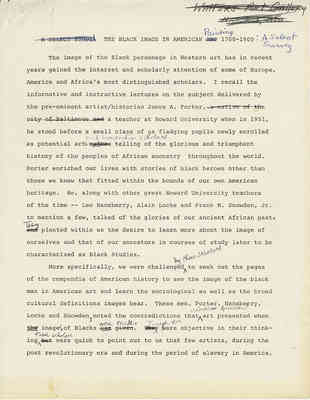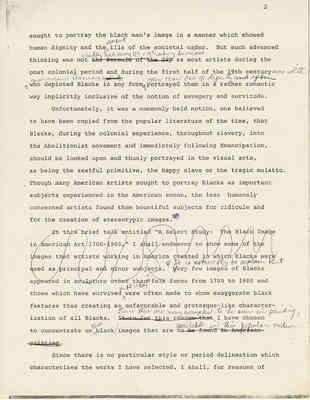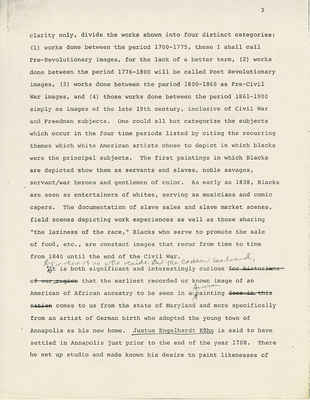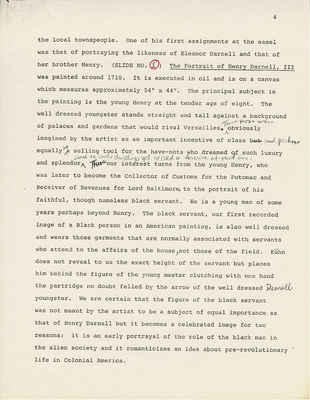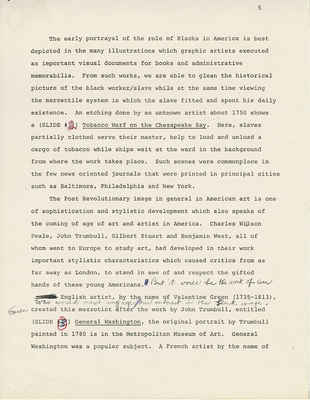Pages
MS01.01.03.B01.F25.001
[crossed out: WATTERS ART GALLERY, MARCH 3, 1980] [crossed out: A SELECT STUDY:]
THE BLACK IMAGE IN AMERICAN PAINTING [crossed out: art] 1700-1900: A SELECT SURVEY
The image of the Black personage in Western art has in recent years gained the interest and scholarly attention of some of Europe, America and Africa's most distinguished scholars. I recall the informative and instructive lectures on the subject delivered by the pre-eminent artist/historian James A. Porter, [crossed out: a native of the city of Baltimore and] a teacher at Howard University when in 1951, he stood before a small class if us fledging pupils newly enrolled as potential arts [crossed out: majors] and humanities scholars telling of the glorious and trumphant history of the people of African ancestry thoughout the world. Porter enriched our lives with stories of black heroes other than those we knew that fitted within the bounds of our own American heritage. He, along with other great Howard University teachers of the time -- Leo Hansberry, Alain Locke, and Frank M. Snowden, Jr. to mention a few, talked of the glories of out ancient African past. They [crossed out: and] planted within us the desire to learn more about the image of ourselves and that of our ancestors in courses of study later to be characterized as Black Studies.
More specifically, we were challenged by these scholars to seek out the pages of the compendia of American history to see the image of the black man in American art and learn the sociological as well as the broad cultural definition images bear. These men, Porter, Hansberry, Locke, and Snowden, noted the contradictions that mainstream American art presented when [crossed out: the] images of Blacks [crossed out: was given] were made. [crossed out: They] Though they were objective in their thinking these scholars [crossed out: but] were quick to point out to us that few artists, during the post revolutionary era and during the period of slavery in America,
MS01.01.03.B01.F25.002
sought to portray the black man's image in a manner which showed human dignity and the rampant ills of the societal order. But such advanced thinking was not [crossed out: the formula of the day] readily had among 18th & 19th century Americans as most artists during the post colonial period and during the first half of the 19th century were white mainstream Americans [crossed out: artists] who depicted Blacks in any form other than one of dignity and often portrayed them in a rather romantic way implicitly inclusive of the notion of savagery and servitude.
Unfortunately, it was a commonly held notion, one believed to have been copied fron the popular literature of the time, that Blacks, during the colonial experience, throughout slavery, into the Abolitionist movement and immediately following Emancipation, should be looked upon and thusly portrayed in the visual arts, as being the zestful primitive, the happy slave or the tragic mulatto. Though many American artist sought to portray Blacks as important subjects experienced in the American scene, the less humanely concerned artists found them bountiful subjects for ridicule and for the creation of stereotypic images. [crossed out: 1]
[crossed out: In this brief talk entitled "A Select Study: The Black Image in American Art 1700-1900," I shall endeavor to show some of the images that artists working in America created in which Blacks were used as principal and minor subjects.]
It is noteworthy to explain that very few images of Blacks appeared in sculpture other than folk forms from 1700 to 1900 and those which have survived until they were often made to show exaggerate black features thus creating an unfavorable and grotesque-like characterization of all Blacks. [crossed out: It is for this reason that] Since there are many examples to be seen in painting, I have chosen to concentrate on those black images that are [crossed out: to be found in American painting] available in this popular medium.
Since there is no particular style or period delineation which characterizes the works I have selected, I shall, for reasons of
MS01.01.03.B01.F25.003
clarity only, divide the works shown into four distinct catergories:(1) works done between 1700-1775, these I shall call Pre-Revolutionary images, for the lack of a better term, (2) works done between the period 1776-1800 will be called Post Revolutionary images, (3) works done between the period 1800-1860 as Pre-Civil War images, and (4) those works done between the period 1861-1900 simply as images of the 19th century, inclusive of Civil War and Freedom subjects. One could all but categorize the subjects which occur in the four time periods listed by citing the recurring themes which white American artists chose to depict in which blacks were the principal subjects. The first painting in which Blacks are depicted show them as servants and slaves, noble savages, servant/war heros and gentlemen of color. As early as 1838, Blacks are seen as entertainers of whites, serving as musicians and comic capers. The documentation of slave sales and slave market scenes, field scenes depicting work experiences as well as those sharing "the laziness of the race," Blacks who serve to promote the sale of food, etc., are constat images that recur from time to time from 1840 until the end of the Civil War. For those of us who reside on the eastern seaboard, it is both significant and interestingly curious that the earliest record or known image of an American of African ancestry to be seen in a American painting comes to us from the state of Maryland and more specifically from an artist of German birth who adoped the young town of Annapolis as his new home. Justus Engelhardt Kuhn is said to have settle in Annapolis just prior to the end of the year 1708. There he set up studio and made known his desire to paint likenesses of
MS01.01.03.B01.F25.004
the local townspeople. One of his first assignments at the easel was that of portraying the likeness of Eleanor Darnell and that of her brother Henry. (SLIDE NO. 1) [underline]The Portrait of Henry Darnell, III [/underline] was painted around 1710. It is executed in oil and is on a canvas which measures approximately 54" x 44". The principal subject in the painting is the young Henry at the tender age of eight. The well dressed youngster stands straight and tall against a background of palaces and gardens that would rival Versailles. These props were obviously imagined by the artist as an important incentive of class [crossed out: but] and perhaps equally so a selling tool for the have-nots who dreamed of such luxury and splendor since no such dwellings yet existed in America at that time. [crossed out: But] Thus our interest turns from the young Henry, who was later to become the Collector of Customs for the Potomac and Reciever of Revenues for Lord Baltimore, to the portrait of his faithful, though nameless Black servant. He is a young man of some years perhaps beyond Henry. The black servant, our first recorded image of a Black person in an American painting, is also well dressed and wears those garments that are normally associated with servants who attend to the affairs of the house, not those of the field. Kuehn does not reveal to us the exact height of the servant but places him behind the figure of the young master clutching with one hand the partridge no doubt felled by the arrow of the well dressed Darnell youngster. We are certain that the figure of the black servant was not meant by the artist to be a subject of equal importance as that of Henry Darnell but it becomes a celebrated image for two reasons: it is an early portrayal of the role of the black man in the alien society and it romanticizes an idea about pre-revolutionary life in Colonial America.
MS01.01.03.B01.F25.005
The early portrayal of the role of Blacks in America is best depicted in the many illustrations which graphic artists executed as important visual documents for books and administrative memorabilia. From such works, we are able to glean the historical picture of the black worker/slave while at the same time viewing the mercantile system in which the slave fitted and spent his daily existence. An etching done by an unknown artist about 1750 shows a (SLIDE #2) [ul] Tobacco Warf on the Chesapeake Bay [/ul]. Here, slaves partially clothed served their master, help to load and unload a cargo of tobacco while ships wait at the word in the background from where the work takes place. Such scenes were commonplace in the few news oriented journals that were printed in principal cities such as Baltimore, Philadelphia and New York.
The Post Revolutionary image in general in American art is one of sophistication and stylistic development which also speaks of the coming of age of art and artists in America. Charles Wilson Peale, John Trumbull, Gilbert Stuart and Benjamin West, all of whom went to Europe to study art, had developed in their work important stylistic characteristics which caused critics from as far away as London, to stand in awe of and respect the gifted hands of these young Americans. But it would be the work of an [deleted: an] English artist, by the name of Valentine Green (17391813), who would next engage our interest in the black image. Green created this mezzotint after the work by John Trumbull, entitled (SLIDE E) [ul] General Washington [/ul], the original portrait by Trumbull painted in 1780 is in the Metropolitan Museum of Art. General Washington was a popular subject. A French artist by the name of
